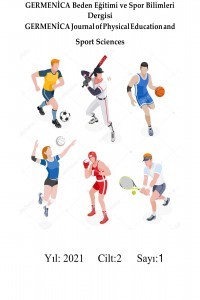14-17 YAŞ GRUBU VOLEYBOLCULARDA REAKTİF KUVVET İNDEKSİ VE BACAK SERTLİĞİNİN BAZI PERFORMANS TESTLERİ İLE İLİŞKİSİNİN İNCELENMESİ
Bu araştırma, 14-17 yaş grubu voleybolcularda, reaktif kuvvet indeksi ve bacak sertliğinin bazı performans testleri ile ilişkisinin incelenmesi amacıyla yapıldı. Araştırmaya yaşları ortalaması (15,41 ± 1.23 yıl) boyları ortalamaları (165.81 ± 5.64 cm), vücut ağırlığı ortalamaları (61.00 ± 8.81) olmak üzere toplam 48 kadın voleybolcu katıldı. Smaç sıçrama testinde her sporcunun kendi stili ile smaç uygulaması istendi. Alt ekstremite sertliği hesabı için gerekli veriler OptoJump protokolleri üzerinden alındı. Bacak sertliği Dalleau G, ve arkadaşlarının oluşturduğu bir eşitlik ile hesaplandı. Reaktif kuvvet indeksi 30 cm standart derinlik sıçrama üzerinden alındı. 5 ve 20 metre sprint ölçümlerinde fotosel kullanıldı. Çeviklik testi ise standart T testi ile belirlendi. Değişkenler arasındaki ilişkilerin analizinde Pearson'un r korelasyon testi uygulandı. Reaktif kuvvet indeksi ile 5m sprint arasında (r=0,49) zayıf, 20m sprint arasında (r= 0,66) orta, T-Testi arasında (r=0,44) zayıf ve smaç sıçrama testi arasında (r = 0,77) yüksek ilişki tespit edildi (p= 0,001). Bacak sertliği ile performans testleri arasındaki ilişkiler anlamlı değildi. Bu araştırmanın bulguları 14-17 yaş grubu voleybolcularda, reaktif kuvvet özelliği ile smaç sıçrama arasında yüksek ilişki olduğunu göstermektedir. 14-17 yaş grubu voleybolculara reaktif kuvvet egzersizleri tavsiye edilebilir.
Anahtar Kelimeler:
Bacak Sertliği, Reaktif Kuvvet, Smaç Sıçrama, Voleybol, Sıçrama
___
- Allen Hedrick, M. (2007). Training for high level performance in women's collegiate volleyball: Part I training requirements. Strength and Conditioning Journal, 29(6), 50.
- Arampatzis, A., Bruggemann, G., & Klapsing, G. M. (2001). Leg stiffness and mechanical energetic processes during jumping on a sprung surface. Medicine and science in sports and exercise, 33(6), 923-931.
- Arampatzis, A., Schade, F., Walsh, M., & Brüggemann, G.-P. (2001). Influence of leg stiffness and its effect on myodynamic jumping performance. Journal of electromyography and kinesiology, 11(5), 355-364.
- Brughelli, M., & Cronin, J. (2008). Influence of Running Velocity on Vertical, Leg and Joint Stiffness. Sports medicine, 38(8), 647-657. doi:10.2165/00007256-200838080-00003
- Dalleau, G., Belli, A., Viale, F., Lacour, J.-R., & Bourdin, M. (2004). A simple method for field measurements of leg stiffness in hopping. International journal of sports medicine, 25(03), 170-176.
- Ebben, W. P., & Petushek, E. J. (2010). Using the reactive strength index modified to evaluate plyometric performance. The Journal of Strength & Conditioning Research, 24(8), 1983-1987.
- Hayes, P. R., & Caplan, N. (2014). Leg stiffness decreases during a run to exhaustion at the speed at O2max. European Journal of Sport Science, 14(6), 556-562. doi:10.1080/17461391.2013.876102
- Holmberg, P. M. (2013). Weightlifting to Improve Volleyball Performance. Strength & Conditioning Journal, 35(2), 79-88. doi:10.1519/SSC.0b013e3182889f47
- İnce, İ. (2019). Effects of Split Style Olympic Weightlifting Training on Leg Stiffness Vertical Jump Change of Direction and Sprint in Collegiate Volleyball Players. Universal Journal of Educational Research, 7(1), 24-31.
- Lloyd, R. S., Oliver, J. L., Hughes, M. G., & Williams, C. A. (2011). The influence of chronological age on periods of accelerated adaptation of stretch-shortening cycle performance in pre and postpubescent boys. The Journal of Strength & Conditioning Research, 25(7), 1889-1897.
- Lloyd, R. S., Oliver, J. L., Hughes, M. G., & Williams, C. A. (2012). The effects of 4-weeks of plyometric training on reactive strength index and leg stiffness in male youths. The Journal of Strength & Conditioning Research, 26(10), 2812-2819.
- Maloney, S. J., & Fletcher, I. M. (2018). Lower limb stiffness testing in athletic performance: a critical review. Sports Biomechanics, 1-22. doi:10.1080/14763141.2018.1460395
- Oliver, J., & Smith, P. M. (2010). Neural control of leg stiffness during hopping in boys and men. Journal of electromyography and kinesiology, 20(5), 973-979.
- Özbay, S. (2019). The Effects of Different Types of Strength Training for Recreational Purposes on the Body Composition and Strength Development of University Students. Asian Journal of Education and Training, 5(2), 381-385.
- Özbay, S., & Ulupinar, S. (2018). The Effect of Moderate-Intensity Technical Training and Resistance Training on Selected Hematological Parameters of Elite Wrestlers. Universal Journal of Educational Research, 6(11), 2679-2682.
- Sheppard, J. M., Gabbett, T., Taylor, K.-L., Dorman, J., Lebedew, A. J., & Borgeaud, R. (2007). Development of a repeated-effort test for elite men’s volleyball. International Journal of Sports Physiology and Performance, 2(3), 292-304.
- Thomas, C., Jones, P. A., & Comfort, P. (2015). Reliability of the dynamic strength index in college athletes. International journal of sports physiology and performance, 10(5), 542-545.
- Watts, D. G., Kelly, V. G., & Young, K. P. (2012). The efficacy of a four-week intervention of complex training on power development in elite junior volleyball players. J Aust Strength Cond, 20(2), 12-22.
- Başlangıç: 2020
- Yayıncı: Kahramanmaraş Sütçü İmam Üniversitesi
